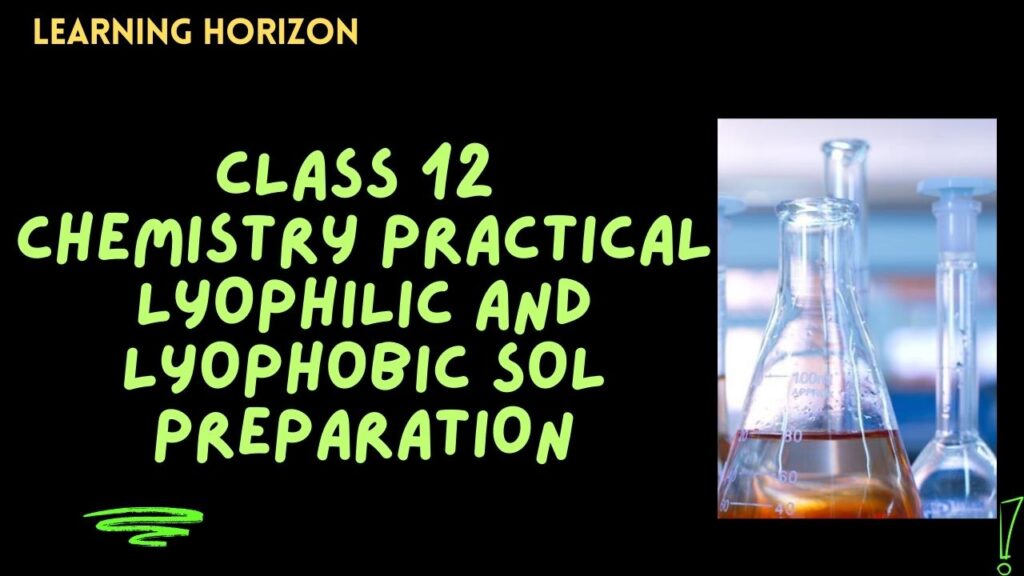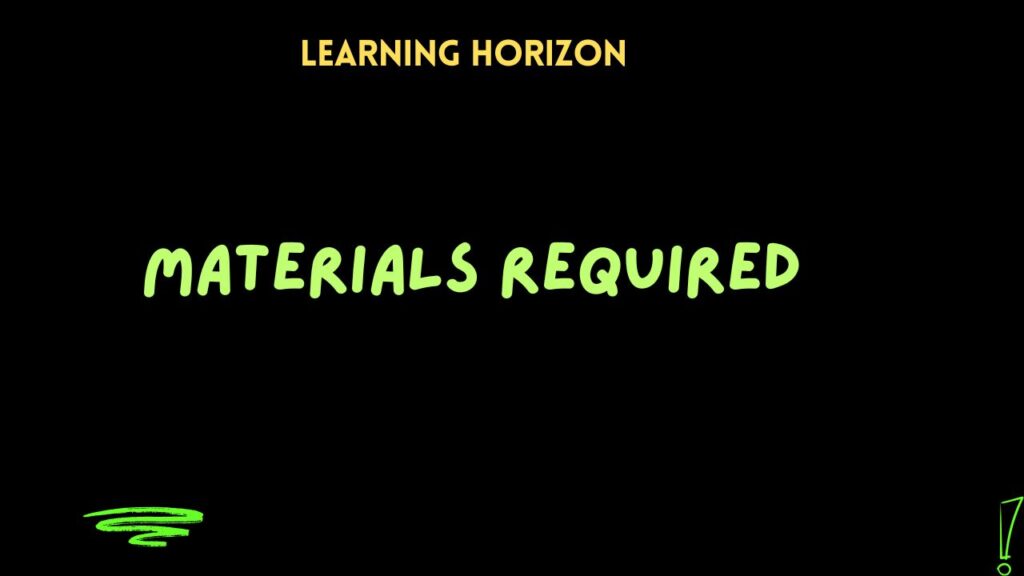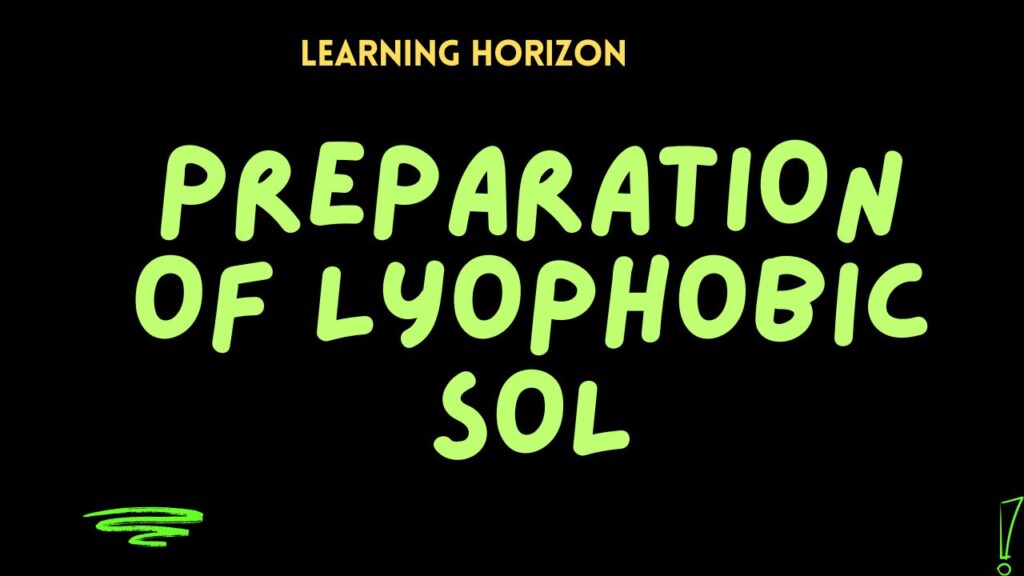
Class 12 Chemistry Practical – Lyophilic and Lyophobic Sol Preparation
(a) Preparation of Lyophilic Sol

(e.g., Starch sol)
Materials Required:

- Starch powder – 1 g
- Distilled water – 100 mL
- Beaker
- Burner
- Stirring rod
- Funnel
- Filter paper
Procedure:

- Take 1 g starch powder in a small beaker.
- Add 10 mL of cold distilled water and stir to make a paste.
- Boil 90 mL of distilled water separately.
- Slowly add the starch paste to boiling water while stirring continuously.
- Boil the mixture for about 5–10 minutes until a clear sol forms.
- Cool and filter the sol through filter paper.
Observation:

A clear colloidal solution (sol) of starch is obtained.
Conclusion:

Starch forms a stable lyophilic sol by direct dissolution in water.
(b) Preparation of Lyophobic Sol

(e.g., Ferric hydroxide sol)
Materials Required:
- Ferric chloride (FeCl₃) solution – 1%
- Distilled water – 100 mL
- Beaker
- Dilute ammonia (NH₄OH)
- Dropper
- Stirring rod
Procedure:
- Take 100 mL of hot distilled water in a beaker.
- Add a few drops of 1% FeCl₃ solution while stirring.
- Then, add dilute NH₄OH dropwise while continuously stirring.
- A reddish-brown turbidity appears due to the formation of ferric hydroxide.
- Continue adding till no more precipitate appears and the mixture becomes colloidal.
Observation:
A reddish-brown colloidal solution of Fe(OH)₃ is formed.
Conclusion:
Fe(OH)₃ sol is a typical lyophobic sol, prepared by a chemical reaction (condensation method).
📘 Precautions:
- Use distilled water to avoid impurities.
- Stir continuously to avoid formation of lumps.
- Add ammonia drop by drop to control the reaction.
- Do not overheat the starch sol.
Question discussion
(i) How will you differentiate between a true solution and a colloidal dispersion?
| Property | True Solution | Colloidal Dispersion (Sol) |
|---|---|---|
| Particle size | < 1 nm | 1–1000 nm |
| Appearance | Clear and transparent | Cloudy or translucent |
| Filterability | Passes through filter paper | Passes through filter but not through ultrafilter |
| Tyndall effect | No | Yes |
| Visibility of particles | Not visible under microscope | Visible under ultra-microscope |
| Stability | Very stable | Relatively stable |
(ii) Identify some sols (colloids) used in daily life and mention their importance.
| Daily Colloid | Type | Importance |
|---|---|---|
| Milk | Emulsion | Nutritious food; protein and fat source |
| Blood | Sol | Transports oxygen and nutrients |
| Toothpaste | Gel | Cleans and protects teeth |
| Fog/Clouds | Aerosol | Affects weather and climate |
| Butter | Emulsion | Food product; spreads easily |
| Paint | Sol | Used in coating and coloring surfaces |
| Gelatin (in desserts) | Gel | Used in cooking and pharmaceuticals |
(iii) How do colloids acquire a charge? Why is ferric hydroxide/aluminium hydroxide sol positively charged while arsenious sulphide sol is negatively charged?
Colloids acquire charge due to:
- Preferential adsorption of ions from the solution onto their surface.
- Ionization of surface groups.
Why the charge difference?
- Fe(OH)₃ and Al(OH)₃ sols: These colloids adsorb H⁺ ions (from water or acids), making them positively charged.
- As₂S₃ sol: Adsorbs S²⁻ or OH⁻ ions, making it negatively charged.
(iv) What is coagulation? How is coagulation different from peptization?
Coagulation:
- The process by which colloidal particles aggregate and settle down.
- Caused by adding electrolytes, heating, or mixing oppositely charged sols.
- Irreversible.
Peptization:
- Conversion of a precipitate into a colloid by adding a small amount of suitable electrolyte.
- Reversible process.
Difference:
- Coagulation → Colloid to precipitate
- Peptization → Precipitate to colloid
(v) How can you convert a colloidal dispersion of sulphur into a true solution?
To convert a colloidal sulphur sol into a true solution:
- Use dialysis or ultrafiltration to remove colloidal particles.
- Or add suitable solvents and increase temperature to dissolve sulphur into molecular form.
However, in general, colloidal sulphur cannot become a true solution easily because the particles are not molecularly soluble.
(vi) Out of lyophilic and lyophobic sols, which one can be easily converted into a gel and why?
Lyophilic sols can be easily converted into gels because:
- They have a strong affinity for the dispersion medium.
- They can form interconnected networks due to hydration or heating/cooling cycles.
Example: Gelatin → gel on cooling.
(vii) Differentiate between a gel and a sol.
| Property | Gel | Sol |
|---|---|---|
| Phase | Solid continuous, liquid dispersed | Liquid continuous, solid dispersed |
| Flow property | Semi-solid, does not flow | Flows like a liquid |
| Examples | Jelly, butter, cheese | Paint, starch sol |
(viii) Applications of colloids in:
🔬 Medicine:
- Drug delivery: Colloidal carriers deliver drugs to specific sites.
- Colloidal silver: Antiseptic.
- Colloidal gold: Used in rheumatoid arthritis treatment.
🛡️ Defense:
- Smoke screens: Colloidal fog or aerosol is used in battlefields.
- Artificial clouds: For camouflage or weather modification.
🚀 Rocket Technology:
- Solid fuel gels: Used in rocket propellants.
- Colloidal systems: Used for nano-coatings and heat-resistant materials.